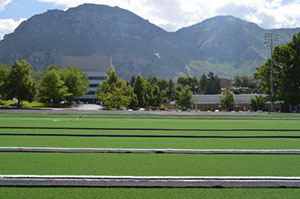AstroTurf provides practice field surface at BYU

AstroTurf provided the new synthetic surface on the football practice field at Brigham Young University. Photo: AstroTurf
AstroTurf has announced it provided the new synthetic surface on the football practice field at Brigham Young University in Provo, Utah.
“Here at AstroTurf, our dedication to safety as a vital component of the products we create is unparalleled,” said AstroTurf President Bryan Peeples. “We’re excited to have the Cougars practice on our playing surface.”
The 97,000-ft. playing surface features a customized version of the company’s GameDay Grass 3D 52 Xtreme product. It includes lining for soccer and lacrosse, however its primary designation will be as a football practice field. A thick rubber shock pad called an E-Layer was installed under the turf to further enhance safety.
AstroTurf’s GameDay Grass performed closest to natural grass and demonstrated the lowest torque output of any synthetic product measured, according to a recent study published by Michigan State University and funded by NFL Charities. The company said this is due to proprietary RootZone technology, an infill stabilization system composed of a thatch layer of textured nylon running under the polyethylene fibers throughout the field. By preventing splash and migration of the loose rubber infill particles and thus maintaining a uniform and consistent surface, the RootZone promotes a more natural biomechanical function of cleat penetration and release. In addition, GameDay Grass surfaces with RootZone technology prevent the deep cleat penetration seen in other heavily infilled surfaces, which can lead to lower extremity injuries, according to AstroTurf.
AstroTurf also supplied a green-coated styrene-butadiene rubber (SBR) infill that absorbs less heat than traditional black rubber infill. Green SBR, especially in combination with the company’s AstroFlect technology, effectively reduces field temperatures without the disadvantages of certain organic infill materials like cork and coconut husks that are sometimes heralded as effective heat-reducing agents. Cork tends to migrate, float, and even rot on the field, while green SBR offers trusted performance, the company said.
Local certified installation contractor, Condor Turf, handled the project, which was completed in June.
The school’s football team begins its third season as an independent this fall after leaving the Mountain West Conference in 2011.








